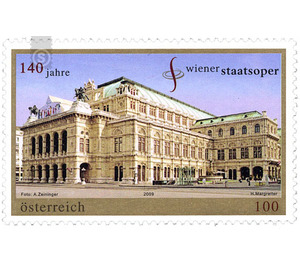140 years - Austria / II. Republic of Austria 2009 - 100 Euro Cent
Theme: Art & Culture
| Country | Austria / II. Republic of Austria |
| Issue Date | 2009 |
| Face Value | 100.00 |
| Edition Issued | 400,000 |
| Printing Type | offset |
| Stamp Type | Commemorative |
| Item Type | Stamp |
| Chronological Issue Number | 2144 |
| Chronological Chapter | OOS-OE2 |
| SID | 749762 |
| In 62 Wishlists | |
If you look at the elegant building of the opera ring, that is, from its front, you have the historical part that survived from the original construction of 1869. The facades are decorated in Renaissance style, while the loggia on the side of the ring road impressively underlines the public character of the opera house. The two equestrian representations above the main façade of the loggia were erected in 1876. Its creator, Ernst Julius Hähnel, created two winged horses, which are led by the "harmony" and the "muse of poetry". Also from Hähnel come those five bronze statues that stand on pedestals in the arcade arches of the loggia and emphasize the high culture that is offered in this house in an impressive way. In the loggia you will find the famous "Magic Flute Cycle" - painted by Moritz von Schwind. To the right and left of the building are the two old fountains of Josef Gasser, which represent opposing worlds: While the right side shows "Loreley, mourning, love and revenge", on the left side "music, dance, joy and carelessness" illustrated artistic way. The rear part of the two-part building is significantly wider, in it the stage and the associated premises are housed; the narrower front contains the auditorium and the adjoining rooms accessible to the public. Noteworthy are the different roof forms: here the domed roof overhangs the core of the plant, but on the other hand there are also hipped roofs over the crossbeams, saddle roofs over the two-storey connecting buildings and French roofs over the corner towers. Entering the box vestibule, which was preserved in its original form, one gains an immediate impression of the interior of the old opera house, which was largely destroyed on 12 March 1945, ie just before the end of the Second World War. However, the entire main front, the central staircase with the so-called "Feststiege", the Schwindfoyer and the tearoom on the first floor were spared. Music lovers around the world appreciate the first-class productions and performances of the Vienna State Opera. Every year, the famous "Wiener Opernball", which marks the social highlight at the end of each ball season, also attracts international attention.


